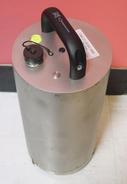
Chapter 1. Preliminary Notes
1.1 Proprietary Notice
The information in this document is proprietary to Güralp Systems Limited and may be copied or distributed for educational and academic purposes but may not be used commercially without permission.
Whilst every effort is made to ensure the accuracy, completeness and usefulness of the information in the document, neither Güralp Systems Limited nor any employee assumes responsibility or is liable for for any incidental or consequential damages resulting from the use of this document.
1.2 Cautions and Notes
Cautions and notes are displayed and defined as follows:
Caution: A yellow triangle indicates a chance of damage to or failure of the equipment if the caution is not heeded.
Note: A blue circle indicates indicates a procedural or advisory note.
1.3 Manuals and Software
All manuals and software referred to in this document are available from the Güralp Systems website: www.guralp.com unless otherwise stated.
1.4 Conventions
Throughout this manual, examples are given of command-line interactions. In these examples, a fixed-width typeface will be used:
Example of the fixed-width typeface used.
Commands that you are required to type will be shown in bold:
Example of the fixed-width, bold typeface.
Where data that you type may vary depending on your individual configuration, such as parameters to commands, these data are additionally shown in italics:
Example of the fixed-width, bold, italic typeface.
Putting these together into a single example:
System prompt: user input with variable parameters
1.5 A note on terminology
Scientists and engineers from different disciplines often use different terminology to describe similar concepts. The following terminology is used consistently throughout this document.
1.5.1 Sensor
A “sensor” is an accelerometer, velocimeter or other transducer (e.g. geophone or hydrophone) with an analogue output - i.e. where a continuously varying voltage is used to represent the magnitude of the quantity being measured.
A sensor cannot generally be used as a standalone component: it forms a sub-assembly of an instrument (see below).
1.5.2 Instrument
 An “instrument” is the assembly of sensors, control electronics, casing and connectors. An example of an instrument is the CMG-3T seismometer shown on the right.
An “instrument” is the assembly of sensors, control electronics, casing and connectors. An example of an instrument is the CMG-3T seismometer shown on the right.
A digital instrument is one that combines one or more sensors with a digitiser; their part numbers include a 'D'. A 3TD, for example, is a 3T instrument combined with a DM24 digitiser.
Within this document, the term “digital sensor” is used in two contexts: when discussing digital inputs (which may be connected to either digitisers or digital sensors) and when describing configuration items which apply to both the digitiser modules embedded within digital sensors and to stand-alone digitisers.
1.5.3 Digitiser
 A “digitiser” is an electronic device designed to accept analogue inputs from one or more sensors and, using sampling techniques, convert these analogue signals into streams of numerical data, which are then stored or transmitted digitally.
A “digitiser” is an electronic device designed to accept analogue inputs from one or more sensors and, using sampling techniques, convert these analogue signals into streams of numerical data, which are then stored or transmitted digitally.
An example of a digitiser is the CMG-DM24 shown in the image above.